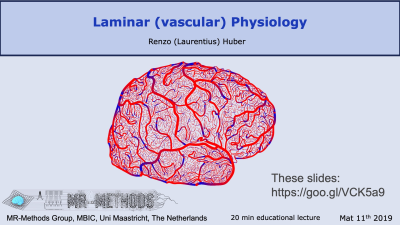Physiology & Hemodynamics
Physiology & Hemodynamics
Weekend Course
Weekend Course
ORGANIZERS: Hanzhang Lu, Richard Buxton, Susan Francis, Benedikt Poser
Saturday, 11 May 2019
| Room 512A-H | 13:30 - 16:40 | Moderators: Richard Buxton, Benedikt Poser |
Skill Level: Intermediate
Session Number: WE-10
Overview
This session at intermediate level will cover the broad range of topics related to cerebral physiology and hemodynamics.
Target Audience
This course is designed for basic scientists and clinicians who would like to gain an understanding and working knowledge of brain physiology and hemodynamics, in both depth and breadth. This course assumes basic knowledge of BOLD fMRI, neuroscience, MR data acquisition, and basic analysis methods.
Educational Objectives
As a result of attending this course, participants should be able to:
- Describe the mechanisms behind neurovascular coupling;
- Identify approaches to BOLD modeling and experimental BOLD calibration;
- Discuss approaches to studying and interpreting baseline physiology; and
- Explain relation to cardiovascular response.
Overview
This session at intermediate level will cover the broad range of topics related to cerebral physiology and hemodynamics.
Target Audience
This course is designed for basic scientists and clinicians who would like to gain an understanding and working knowledge of brain physiology and hemodynamics, in both depth and breadth. This course assumes basic knowledge of BOLD fMRI, neuroscience, MR data acquisition, and basic analysis methods.
Educational Objectives
As a result of attending this course, participants should be able to:
- Describe the mechanisms behind neurovascular coupling;
- Identify approaches to BOLD modeling and experimental BOLD calibration;
- Discuss approaches to studying and interpreting baseline physiology; and
- Explain relation to cardiovascular response.
| 13:30 |
Neurovascular Coupling
Claudine Gauthier
The brain has a high energy demand, but cannot store energy. Consequently, it requires an uninterrupted and tightly controlled influx of blood to function. Neurovascular coupling comprises all mechanisms that determine cerebral blood flow (CBF) regulation following neuronal activity. The neurovascular unit is highly complex, involving excitatory neurons, interneurons, components of blood vessel walls such as smooth muscle cells and pericytes, as well as perivascular cells such as astrocytes and macrophages. All these cells can release molecules that can lead to vasodilation or vasoconstriction, and thereby determine the CBF response that accompanies neuronal activity, and therefore hemodynamic imaging signals.
|
|
| 13:50 |
HRF: Modeling & Transients
Martin Havlicek
Hemodynamic response measured with blood oxygenation level-dependent (BOLD) fMRI typically exhibit transients in the form of early-overshoot and post-stimulus undershoot. These transients originate from dynamic relationships between different physiological variables. They can be related to (1) active neuronal and metabolic processes reflecting changes in excitatory-inhibitory (E-I) balance; or (2) passive vascular venous blood volume changes due to vessel viscoelasticity. In this lecture, I will explain how dynamic physiological models, accounting for both active and passive mechanisms underlying BOLD response (BR) transients, can help us to study dynamic changes in E-I balance using fMRI data.
|
|
| 14:10 |
 |
Laminar Physiology
Laurentius Huber
Recent methodological advancements of fMRI allow researchers to approach the mesoscopic regime of cortical layers and columns. This revolutionizes the ability to tackle cortical information processing within brain systems. In order to interpret the layer-dependent fMRI signal, however, the underlying laminar physiology must be understood. In this educational lecture, I will give an overview of the physiology of blood vessels within GM and discuss how this physiology affects the interpretation of layer-fMRI signal changes. I will give an overview of the corresponding fMRI analysis challenges. And finally, I will discuss how intra-cortical blood vessels can differently affect fMRI contrasts of BOLD and non-BOLD sequences.
|
| 14:30 |
Cardiovascular Response
Kevin King
We will discuss how new MRI techniques allow us to identify various stages of brain response to cardiovascular disease.
|
|
| 14:50 |
Break & Meet the Teachers | |
| 15:20 |
Calibrated BOLD
Daniel Bulte
Blood oxygenation level dependent (BOLD) functional MRI is a powerful tool for localising neural activity, but it provides an ambiguous physiological signal. A number of methods exist for calibrating the BOLD signal in order to provide either relative changes in a physiological parameter such as CBF and CMRO2 during the performance of a task, or to produce quantitative maps of physiological parameters at rest. This session will introduce the basic science behind some of the most popular methods of BOLD calibration.
|
|
| 15:40 |
MRI Measurement of OEF and CMRO2
Felix Wehrli
The cerebral metabolic rate of oxygen (CMRO2) is fundamental to tissue metabolism. Determination of CMRO2 demands knowledge of the arterio-venous difference in hemoglobin-bound oxygen concentration, typically expressed as oxygen extraction fraction (OEF), and cerebral blood flow rate (CBF). MRI is uniquely suited for measurement of both these quantities, yielding CMRO2 in absolute physiologic units of µmol O2 min-1/100g tissue. Two approaches will be discussed, both relying on hemoglobin magnetism. The first is based on measurement of blood water T2, which is modulated by diffusion and exchange in the local induced fields in the vicinity of erythrocytes. The second exploits the blood’s bulk magnetic susceptibility, which can be derived from field maps.
|
|
| 16:00 |
Understanding Baseline: Arterial Compliance
Esther Warnert
Understanding Baseline: Arterial Compliance.
|
|
| 16:20 |
Understanding Baseline: Non-Gd BBB Video Permission Withheld
Jack Wells
Alterations to the integrity of the blood brain barrier (BBB) appear to be mechanistically important in the development of neurodegenerative disease. Traditionally, BBB integrity is measured by investigating the transfer of intravascular contrast agents, such as gadolinium or evans blue, into the brain parenchyma. Alternative, non-invasive, MRI techniques have been proposed that harness arterial spin labelling sequences to assess the permeability of the BBB to water, potentially yielding a sensitive marker of subtle pathological changes. In this lecture I will review these non-invasive techniques and how they have been applied to investigate abnormalities to BBB integrity in disease.
|
|
| 16:40 |
Adjournment & Meet the Teachers |
 Back to Program-at-a-Glance |
Back to Program-at-a-Glance |  Back to Top
Back to Top